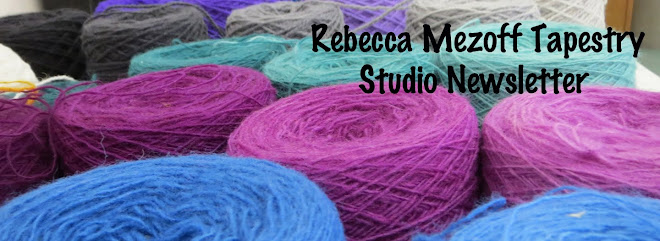The Latest Catastrophe
I often get questions from students similar to the one I found in my inbox this morning. I thought some of you might be interested in the solution to this common problem.The student started the email with, "Hi Rebecca, Here is my latest catastrophe. I am so discouraged."
She went on to say:
I think it is a tension problem. I am currently weaving pick by pick. There are exactly the same number of rows of weft all the way across!!! So what the heck is going on? You can see the left side is packed way tighter, but that’s not the answer. And it makes it look even more weird. I need to sort out these issues or I think I won’t have the confidence to weave at all. There is so much time invested to just throw something away. I so much enjoy the process of weaving but I want some confidence that I won’t have to throw all my projects away. I so hope you can help me.
The good thing is that I took one look at this photo and knew exactly what the problem is. She is weaving this on a two-foot Shannock and was thinking that this was caused by a warp tension problem so she tried to improve the tension on the left side of the piece. I can't feel the tension so I don't know if it is even, but that isn't the problem in this case.
The problem is WEFT tension, not warp tension. It is true that if you have a section of warp that is looser, you'll get a bubbling up of the weft. But that isn't what is happening here. One of the most important things in tapestry is to get the right amount of weft into your warp, and that is something that an experienced weaver learns to adjust constantly and mostly without thought.
Look at the warp spacing in the photo. The warps on the left where the fell line is rising are very close together compared to the rest of the piece. When warps get close together like this, there isn't anywhere for the weft to go because the space becomes so small, so it pushes up. Often people try putting less and less weft in in this case to try to fix the problem and that is the opposite of what has to happen. This piece is effectively now being woven eccentrically on the left side which only exacerbates the problem as you need even MORE weft in eccentric weaving to maintain warp spacing.
Consider what happens with the wefts in cross section:
When your warps start to get too close together, you need to put more weft in. Said another way, when your warps get crowded together, you need to increase the bubbling in that section. Make those bubbles bigger, not smaller. The extra weft you put in will start to push the warps apart and you won't have this problem of the rising fell line. (Notice that she is also having difficulty even covering the warp with the weft and has had to pack the left side of the piece very hard to keep the warp covered. This is a situation where you'll often see lice.)
Conversely, if you have areas where your warps are spreading apart, you need to put less weft in. Often in areas where there is a lot going on, the warps start to spread out. I will flatten my bubble or use no bubble at all to encourage the warps to come back together in this case. I also sew my slits as I go to help avoid this spreading warp problem.
Weft tension, or the amount of weft put into the warp with each pick, is something that has to be constantly adjusted. Watch those warps as you weave and then check to make sure your warp tension is even. If it is, you need to watch the amount of weft you're putting in carefully. You can change the areas in one pick that get more or less weft. Areas of warp spread can get much less weft (straight line), areas of warp crowding can get much more weft (bigger bubbles which increases amount of weft).
Here is a video that shows this bubbling problem.
The entire video is part of my new online tapestry techniques class. Visit www.rebeccamezoff.com/online-learning/ for more information. Part 3 of the class has a whole module on weft tension.
This student's piece was an extreme case where I advocated unweaving or filling in the low areas and then aggressively working to get those warps on the left to move apart. Do you have other ideas of how to fix this problem? Please leave your thoughts in the comments section below if you do!
For continued updates on my fiber adventures, subscribe to my newsletter (I'm going to a wool mill tomorrow! You can bet I'll have something to say about that!). The subscription box is in the upper right corner of this blog, or click HERE.


























